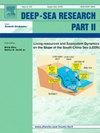法国比斯开湾Guilvinec峡谷晚全新世及近代冷水珊瑚碳酸钙生产
IF 3
3区 地球科学
Q2 OCEANOGRAPHY
Deep-sea Research Part Ii-topical Studies in Oceanography
Pub Date : 2024-12-29
DOI:10.1016/j.dsr2.2024.105451
引用次数: 0
摘要
在大陆架和斜坡环境中,包括海底峡谷,冷水珊瑚礁和群落可能是当地重要的碳酸钙工厂。在这里,我们对比斯开湾北部Guilvinec峡谷750-850米深度范围内的殖民地核状珊瑚群落的珊瑚碳酸盐产量进行了短期和长期估计。短期(年-年)估算是利用当地珊瑚骨骼生物量计算的,根据ROV视频调查的珊瑚大小和丰度进行估算,当地产生的珊瑚群落大小和湿重之间的物种特异性回归,以及公布的Lophelia pertusa和Madrepora oculata的日或年增长率。对同一珊瑚礁的长期(世纪-千年)碳酸盐增生的估计是通过同一珊瑚群落的活塞岩心得出的。Guilvinec峡谷珊瑚丘的平均活菌落骨骼肌生物量为153.9±39.4 g CaCO3 m−2。根据已公布的增长率,平均每年碳酸钙总产量为6.85±1.79 g CaCO3 m−2 y−1,范围为0-30.2 g CaCO3 m−2 y−1。这一碳酸盐产量比之前挪威大陆架的估计要低一个数量级。通过ct扫描分析了2011年通过丘的活塞芯,并对珊瑚丰度进行了亚采样。根据岩心中珊瑚碎片先前的14C和U/Th年龄的年龄模型得出,在过去~ 2150年间,珊瑚碳酸盐的长期平均吸积率为78 g CaCO3 m−2 y−1,上半部分的范围为40.8(岩心底部)至148.5 g CaCO3 m−2 y−1,比以前在其他地区的估计低约1 - 2个数量级。与东北大西洋其他地区相比,Guilvinec峡谷土丘的低碳酸盐增加率可能归因于近期活珊瑚覆盖率的下降,从ROV调查中可以看出,该地点的活珊瑚丰度较低。本文章由计算机程序翻译,如有差异,请以英文原文为准。
Late Holocene and recent cold-water coral calcium carbonate production in Guilvinec Canyon, Bay of Biscay, France
Cold-water coral reefs and communities can be locally important calcium carbonate factories in continental shelf and slope environments, including submarine canyons. Here we present short-term and long-term estimates of coral carbonate production by colonial scleractinian coral communities in the 750–850 m depth range in Guilvinec Canyon, northern Bay of Biscay. Short-term (annual-decadal) estimates were calculated using local coral skeletal biomass, estimated as a product of coral size and abundance from ROV video surveys, a locally generated species-specific regression between coral colony size and wet weight, and published daily or annual percent growth rates for Lophelia pertusa and Madrepora oculata. A long-term (century-millennial) estimate of carbonate accretion for the same reef was derived from a piston core through the same coral community.
Average live colonial scleractinian skeletal biomass in the Guilvinec Canyon coral mounds was 153.9 ± 39.4 g CaCO3 m−2. Applying published growth rates, the average annual gross carbonate production was 6.85 ± 1.79 g CaCO3 m−2 y−1, range 0–30.2 g CaCO3 m−2 y−1. This carbonate production rate was about one order of magnitude lower than previous estimates from the Norwegian shelf.
A 2011 piston core through the mound was analyzed by CT-scan and subsampled for coral abundance. An age model from previous 14C and U/Th ages of coral fragments in the core yielded a long-term average coral carbonate accretion rate of 78 g CaCO3 m−2 y−1 over the past ∼2150 y, range 40.8 (core-bottom) to 148.5 g CaCO3 m−2 y−1 in the upper half, about 1–2 orders of magnitude lower than previous estimates from other regions.
Low carbonate accretion rates observed in the Guilvinec Canyon mounds could be attributable to recent declines in live coral cover, indicated by low abundance of live corals in ROV surveys from this site, compared to other regions of the Northeast Atlantic.
求助全文
通过发布文献求助,成功后即可免费获取论文全文。
去求助
来源期刊
CiteScore
6.40
自引率
16.70%
发文量
115
审稿时长
3 months
期刊介绍:
Deep-Sea Research Part II: Topical Studies in Oceanography publishes topical issues from the many international and interdisciplinary projects which are undertaken in oceanography. Besides these special issues from projects, the journal publishes collections of papers presented at conferences. The special issues regularly have electronic annexes of non-text material (numerical data, images, images, video, etc.) which are published with the special issues in ScienceDirect. Deep-Sea Research Part II was split off as a separate journal devoted to topical issues in 1993. Its companion journal Deep-Sea Research Part I: Oceanographic Research Papers, publishes the regular research papers in this area.

 求助内容:
求助内容: 应助结果提醒方式:
应助结果提醒方式:


